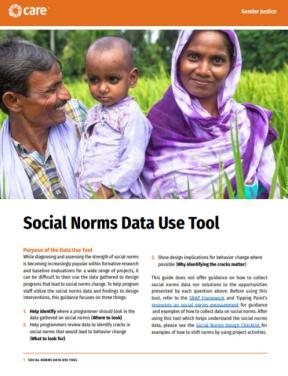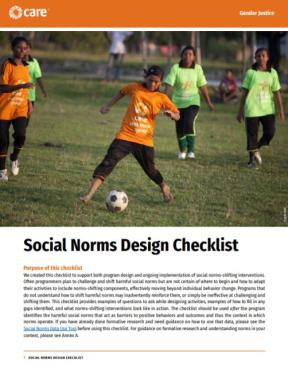- Toolkit
- 4 February 2020
Social norms measurement methods briefs: CARE's Tipping Point initiative
- Author: ESubden
- Published by: Care, Tipping Point

During Phase 1, Tipping Point evaluation drew upon multiple methods for assessing the project’s contributions to changes at community and individual levels, including:
- Photovoice, a highly participatory method of evaluation that simultaneously builds skills and amplifies the participant’s own voice. Tipping Point’s experience with Photovoice is described in this brief for practitioners and researchers who may wish to apply this methodology to another evaluation or learning process.
- SenseMaker®, a narrative-based approach that involves the collection of short stories from targeted participant groups in response to a common prompt, is one of the methodologies used during the Phase 1 evaluation to measure social norms change. In this brief, the Tipping Point’s experience with SenseMaker® is described, including the methodology for data collection and analysis and lessons learned in the process.
- CARE’s Social Norms Analysis Plot (SNAP) framework provides practical guidelines to understand and evaluate norms change. The framework defines components of social norms upon which tools are built, allowing the evaluator to assess the strength of a particular norm and ways it may have shifted over time. The first three components of the SNAP framework are drawn directly from social norms theory and describe the nature of the norm in a given context. The other two components of the SNAP framework further characterize the strength of the norm in question in its current state. The SNAP framework helped guide Tipping Point’s understanding of the nature of norms related to gender equity and child marriage, and how they were shifting, weakening, or remaining fixed.
- Outcome Mapping (OM) is a methodology for planning, monitoring, and evaluating development initiatives that seek to bring about sustainable social change. This method embraces the complexity of change in people and societies, recognizing that change has many drivers. Therefore, rather than seeking to isolate one program’s impact, OM maximizes the opportunities for learning about what is, and what is not, helping to facilitate change in communities.
- Tags:
- Child marriage
- Countries / Regions:
- Nepal, Bangladesh


